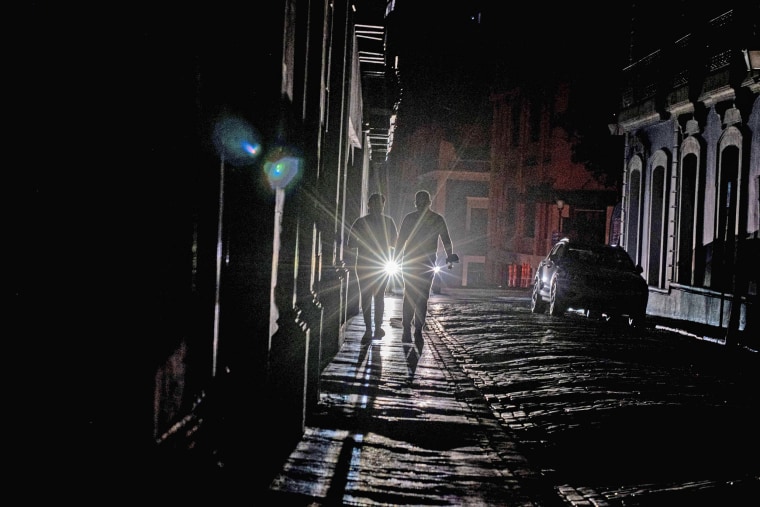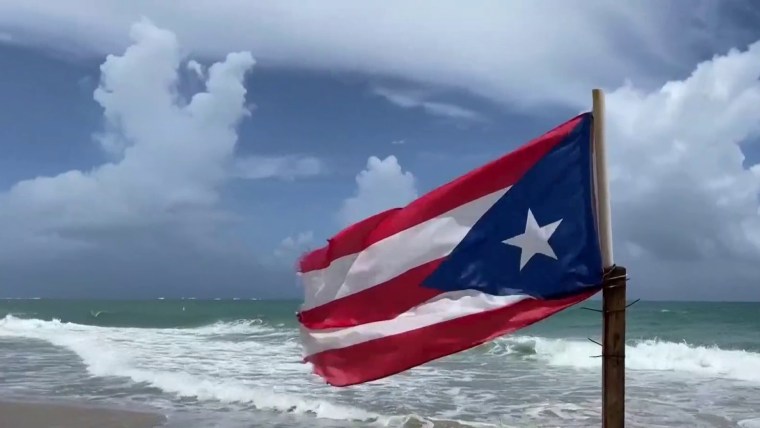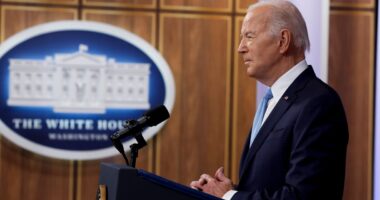Five years ago, Iraida Quiñones survived Hurricane Maria, one of the worst storms to ever hit Puerto Rico and the deadliest natural disaster on U.S. territory in 100 years.
On Friday she was bracing for Tropical Storm Fiona, which was set to bring heavy rains and winds — and a hurricane threat — to the island over the weekend.
“That’s what scared us, that it’s the same date as Maria,” Quiñones, 87, who lives in San Juan, said in her native Spanish. “We associate those kinds of bad times with Maria.”
For Quiñones and other Puerto Ricans, the continuing fragility of Puerto Rico’s power grid five years later is a constant source of concern in a region that expects the possibility of hurricanes every fall.
“Our grid may be functional, but it’s fragile,” said Sergio Marxuach, policy director at the Center for a New Economy, a Puerto Rico-based nonpartisan think tank, adding that the slightest storm winds can easily result in nearly 500,000 homes losing power.
“Five years later, we are still exposed to the same risk,” Marxuach, who recently completed an analysis on the state of Puerto Rico’s electric power system, said. “Progress will continue to be slow unless we find a solution” for all involved federal and local agencies to better coordinate with one another.
Vanelis Rodriguez, a resident of Hato Rey, said she’s “anticipating the power to go out” this weekend over Tropical Storm Fiona, because “we all know how the power system here functions.”
Puerto Rico’s patched-up power grid continually acts up, causing constant blackouts and brownouts across the island.
Hurricane Maria devastated Puerto Rico on Sept. 20, 2017. The roaring winds of the high-end Category 4 hurricane decimated the island’s fragile and very deteriorated electric system, triggering the world’s second-longest blackout.
At least 2,975 people died during Maria’s aftermath, and most of those deaths have been attributed to the lack of electricity and the ensuing interruptions in medical and other services. The blackout not only affected residences; nursing homes and hospitals found themselves without power for extended periods of time.
An additional 514 Puerto Ricans, most of whom were over the age of 65, were estimated to have died on the U.S. mainland as a result of the hurricane “due to the systematic effects on the displaced,” according to a study published this month by the British Medical Journal Open.

More than 200,000 left Puerto Rico for the mainland during Maria’s aftermath, mostly because of the prolonged lack of electricity following the storm’s devastation.
“I had no power, no generator, food shortages. It was difficult, very difficult,” said Quiñones, who left the island two weeks after the storm hit and stayed with her sons on the mainland for several months.
“Emergency power restoration after Hurricane Maria lasted more than one year,” according to Josué Colón, executive director of the Puerto Rico Electric Power Authority, the bankrupt public corporation managing power-generation units on the island.
‘We live ready’
Residents like Rodriguez have experienced longer service restoration times, poor customer service and voltage fluctuations that often damage appliances and other home electronics since June, when Luma Energy, a Canadian-American private company, took over Puerto Rico’s energy transmission and distribution system, according to an analysis by the Institute for Energy Economics and Financial Analysis, a nonprofit research organization.
Puerto Rico depends mostly on imported oil to power its electricity. There has been some progress, spearheaded mainly by nonprofit groups and several private companies, to use renewables, mostly solar panels to counteract the tenuous power grid.
Although the Biden administration and the island’s government have set a goal achieving of 100% renewable electricity by 2050, renewable energy generation is currently at less than 4%.
In a recent congressional hearing on recovery efforts, Shay Bahramirad, a senior vice president at Luma Energy, said the company had done more in the past 15 months to increase energy efficiency than what had been done in the past decade, including connecting more clients to solar energy.
But for most island residents, widespread outages and the rumbling noise of generators have become the norm in Puerto Rico.
Quiñones even lost power Thursday, days before Tropical Storm Fiona even reached Puerto Rico. She said she turned on her generator and waited for the power to come back.
But for many Puerto Ricans like Rodriguez, who don’t have access or can’t afford a generator, constantly plunging into darkness often serves as a reminder of how slow Puerto Rico’s reconstruction has been.
“We live ready,” Rodriguez, 35, said. “We always make sure we’re stocked with batteries, oil lamps, water.”
A few weeks ago, the Federal Emergency Management Agency made $9.5 billion available for Puerto Rico to rebuild its power grid, the largest ever public infrastructure project.
Only 40 power grid reconstruction projects have been approved so far, all of which are expected to be funded with this aid, said Anne Bink, associate administrator of the Office of Response and Recovery at FEMA, during the congressional hearing on Thursday.

Hurricane Maria left $90 billion in damages. Congress allocated at least $71 billion for general recovery and reconstruction operations, of which $62 billion have been made available to the island.
About 72% of those funds have not yet reached local communities, mainly because permanent reconstruction work on the island began in late 2020, according to Rep. Jenniffer Gonzalez, Puerto Rico’s nonvoting member of Congress.
Puerto Rico has already spent $19.9 billion in aid, according to the Central Office of Recovery, Reconstruction and Residency.
The Fiscal Oversight and Management Board overseeing Puerto Rico’s finances has said the remaining bulk of the reconstruction aid is scheduled to be disbursed after fiscal year 2025.
In the meantime, residents were getting ready for another tropical storm, albeit one less destructive than Hurricane Maria.
“What happened with Maria was so violent and a large part of the island has yet not recovered,” Quiñones said.
Follow NBC Latino on Facebook, Twitter and Instagram.
Source: | This article originally belongs to Nbcnews.com












